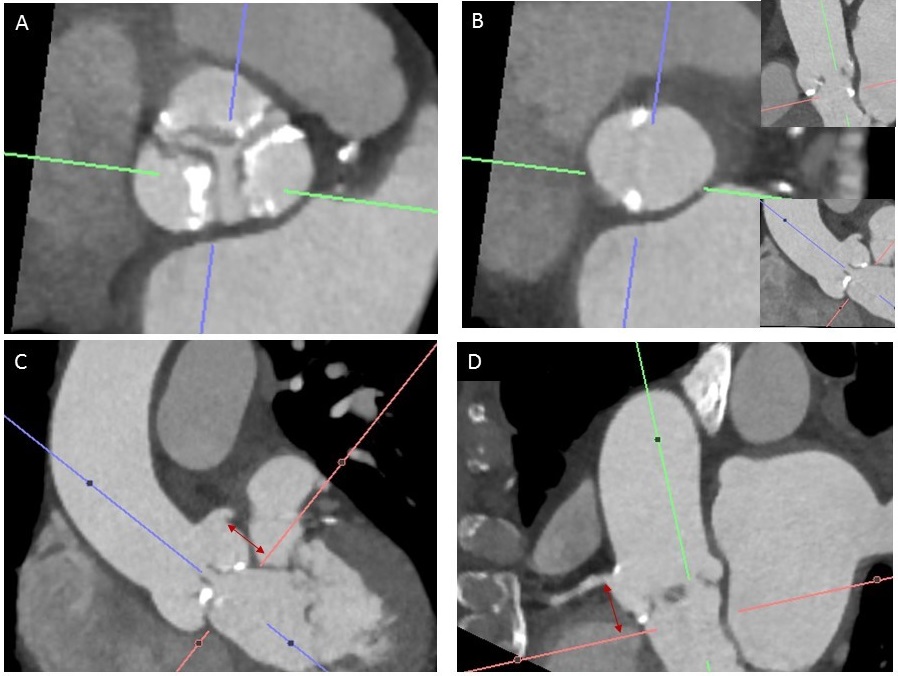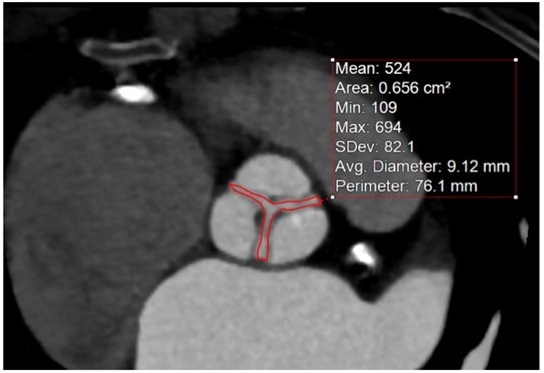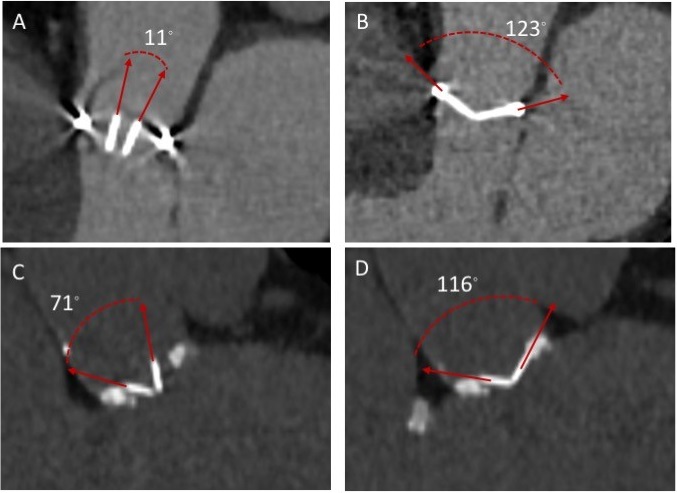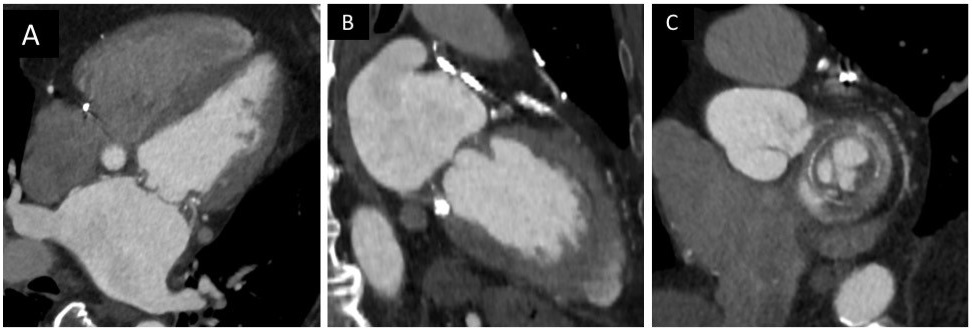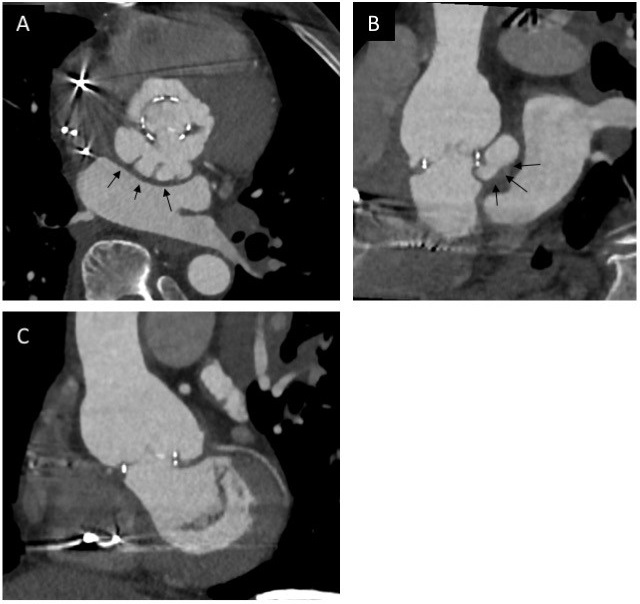Use of CT in the Assessment of Valvular Function
Introduction
Multidetector computed tomography (MDCT) is a useful adjunct imaging modality in the assessment of native and prosthetic heart valve-related complications. Transthoracic echocardiography (TTE) and transesophageal echocardiography (TEE) remain the primary noninvasive modalities for valvular assessment, but MDCT can be useful in the setting of prosthetic heart valves or pre-procedural/pre-operative planning and is less dependent on patient morphology. Appropriate use criteria are reflective of this, indicating that MDCT is appropriate in the setting of suspected bioprosthetic or mechanical heart valve dysfunction and may be appropriate for assessing native valves in the setting of inadequate imaging by TTE or TEE.1
Computed Tomography Assessment of Native Valves
A growing indication for MDCT is in pre-procedural planning of transcatheter heart valve procedures in native aortic and mitral stenosis. One of the strengths of MDCT is in the identification of calcium; echocardiography is limited by its relative inability to distinguish between calcification and dense collagen. MDCT can be used to assess extent of calcification, measure the aortic or mitral annulus, and predict other potential complications such as post valve insertion left ventricular outflow tract obstruction.2-4 For transcatheter aortic valve replacement (TAVR), characterizing the extent of calcium can help predict risk of annular rupture and likelihood of post valve implantation perivalvular leak (Figure 1). The aortic valve area (AVA) can also be measured by planimetry using dynamic four-dimensional (4D) imaging of the valve to identify maximal systolic opening of the valve (typically at 20-25% of the R-R interval) (Figure 2). Studies have shown good correlation between MDCT and TTE (r range: 0.79-0.93), though computed tomography measurements are slightly larger5 and have good concordance with planimetered AVA by TEE (difference of -0.02 cm2 [95% confidence interval -0.16, 0.11], p = 0.71).3
Figure 1
Figure 2
The severity of aortic or mitral valve regurgitation is based on the demonstration of both a large regurgitant orifice area (ROA) and chamber dilation. MDCT can be used to measure the ROA by planimetering the area of aortic cusp or mitral leaflet malcoaptation during diastole and systole, respectively. Several studies have demonstrated good correlation between the ROA of aortic regurgitant jets measured by MDCT and severity of AR diagnosed by TTE (r = 0.79-0.84).6 However, ROA cut-off values measured by MDCT corresponding to mild, moderate, and severe AR are significantly different across studies, likely due to a lack of standardization of measurements. For mitral regurgitation, MDCT can be used to measure mitral valve geometry and identify the anatomic location of mitral valve prolapse with good correlation with three-dimensional (3D) TEE.7 MDCT has also been used with good success in helping surgeons assess patient suitability for minimally invasive or robotic mitral valve repair procedures.
Computed Tomography Assessment of Prosthetic Heart Valves
Prosthetic Valve Dysfunction
Contrast-enhanced MDCT is increasingly used as an adjunct to TTE, TEE, and fluoroscopy in the assessment of prosthetic heart valves. Dynamic 4D imaging, where images are reconstructed from different stages of the cardiac cycle and looped, established MDCT as a valuable imaging modality for the assessment of valve function. Though the temporal resolution is slightly lower than that of echocardiography (83 msec with dual source computed tomography vs. 16-60 msec for echocardiography),5 4D imaging can be used to assess leaflet mobility and valve stability and measure opening and closing angles in the place of fluoroscopy for mechanical valves (Video 1 and Figure 3).8 The integrity of the sewing ring can also be assessed by MDCT. Commonly implanted mechanical bileaflet prosthetic heart valves including those from St. Jude Medical (St. Paul, MN), On-X Life Technologies, Inc. (Austin, TX), and CarboMedics, Inc. (Austin, TX) can be imaged with only mild artifacts. However, Sorin Group USA, Inc. (Arvada, CO) and Björk-Shiley (Shiley Inc.; Irvine, CA) monoleaflet mechanical valves demonstrate extensive artifacts related to their cobalt chrome components that make assessment by MDCT frequently non-diagnostic. Other tilting disc valves, such as the Medtronic-Hall valve (Medtronic Inc.; Minneapolis, MN) can be visualized with reasonable image quality.8,9
Video 1
Figure 3
The assessment of prosthetic heart valve pannus or valve thrombosis is a common indication for MDCT. Both present as hypoattenuating lesions attached to the prosthetic heart valve and can be difficult to differentiate. Certain features, such as lesion location, size, and mobility can be useful in differentiating the two. Pannus formation is more commonly seen on the ventricular side of prosthetic aortic and mitral valves and typically has higher computed tomography attenuation, similar to that of the interventricular septum.8 Thrombus, on the other hand, usually occurs on the atrial side of prosthetic mitral valves and the aortic side of prosthetic aortic valves and has lower attenuation than pannus.9 MDCT can also be helpful in the diagnosis of patient prosthesis mismatch, where valve leaflet motion is demonstrated to be normal, without evidence of pannus or thrombus, but gradients are elevated across the valve, suggesting a small valve orifice area relative to the patient's size.
Leaflet thrombosis of bioprosthetic surgical and transcatheter valves has been increasingly recognized, and studies have shown that MDCT has a higher sensitivity than TTE/TEE for detecting leaflet thrombosis (Figure 4).1,9 In a study by Makkar et al., 22 of 55 patients (40%) from a clinical investigational device exemption trial randomizing patients to the Portico (St. Jude Medical; St. Paul, MN) valve or other commercially available TAVR valve and 17 of 132 patients (13%) from 2 separate registries of TAVR and surgical aortic valve replacement valves were found to have hypoattenuating lesions and reduced leaflet mobility on MDCT.10 As asymptomatic valve thrombosis is increasingly diagnosed by computed tomography, the challenge will be in understanding the clinical relevance of these findings, especially because many patients are asymptomatic at diagnosis.
Figure 4
Endocarditis
Infective endocarditis (IE) involving native and prosthetic valves is a growing indication for MDCT, not merely to noninvasively assess for coronary artery disease but also to better define the anatomical extent of the endocarditis (Figure 5). In their study comparing the use of TEE and MDCT for the diagnosis of IE compared with surgical pathology, Feuchtner et al. studied a total of 29 patients with 46 vegetations and found that both modalities detected valvular vegetations with good sensitivity and specificity on a per valve basis (sensitivity/specificity for TEE was 100%/100% and for MDCT was 96%/97%).11 MDCT failed to detect 5 vegetations due to metal artifact, small size (<4 mm), and inappropriate optimization of right-sided structures for a right-sided vegetation. MDCT also misclassified 2 degenerative lesions as vegetations and failed to detect all cases of valvular perforation. MDCT did provide superior detection and characterization of the presence and extent of perivalvular abscesses and pseudoaneurysms and detected vegetations attached to mechanical valves that were missed by TEE.
Figure 5
This highlights the importance of an integrated imaging approach to IE. Echocardiography alone may be sufficient in uncomplicated IE with localized valve involvement; however, in the setting of complicated IE with prosthetic material, perivalvular involvement, or poor quality echocardiography, computed tomography may be helpful to further characterize the anatomy. Echocardiographic findings should be used to help guide the computed tomography protocol. When using 4D imaging, consideration should be made not to employ dose modulation to ensure optimal signal-to-noise ratio throughout the cardiac cycle and maximize the diagnostic utility of acquired images, especially in older patients for whom the stochastic risk of radiation exposure is less.
Perivalvular Leak
Since first proposed in 1992,12 percutaneous closure of perivalvular leaks has become an increasingly utilized alternative to re-operation. Current computed tomography software enables 3D volume-rendered image reconstruction, which facilitates characterization of the length, width, and area of the leak and also allows image reconstruction in certain angiographic projections to aid operators in crossing the septum and directing the wire across the defect more expeditiously.13 Limitations of computed tomography include artifact from nearby prosthetic valve material or mitral annular calcification, which can result in blooming or beam hardening artifact that can affect perivalvular leak size estimation.
Conclusion
MDCT is gaining utility in the assessment and management of patients with both native and prosthetic heart valve disease. The strength of MDCT is in the assessment of prosthetic heart valves, especially in assessing valve dysfunction or infection, but MDCT is also useful in native valve disease for pre-procedural planning. MDCT does, however, lack the ability to provide hemodynamic information and thus must be integrated with echocardiographic information. In order to harness the full diagnostic potential of MDCT, an understanding of the different techniques for acquiring images and processing data is important.
References
- Doherty JU, Kort S, Mehran R, Schoenhagen P, Soman P. ACC/AATS/AHA/ASE/ASNC/HRS/SCAI/SCCT/SCMR/STS 2017 Appropriate Use Criteria for Multimodality Imaging in Valvular Heart Disease: A Report of the American College of Cardiology Appropriate Use Criteria Task Force, American Association for Thoracic Surgery, American Heart Association, American Society of Echocardiography, American Society of Nuclear Cardiology, Heart Rhythm Society, Society for Cardiovascular Angiography and Interventions, Society of Cardiovascular Computed Tomography, Society for Cardiovascular Magnetic Resonance, and Society of Thoracic Surgeons. J Am Coll Cardiol 2017;70:1647-72.
- Blanke P, Dvir D, Cheung A, et al. Mitral Annular Evaluation With CT in the Context of Transcatheter Mitral Valve Replacement. JACC Cardiovasc Imaging 2015;8:612-5.
- Leipsic J, Wood D, Manders D, et al. The evolving role of MDCT in transcatheter aortic valve replacement: a radiologists' perspective. AJR Am J Roentgenol 2009;193:W214-9.
- Tops LF, Wood DA, Delgado V, et al. Noninvasive evaluation of the aortic root with multislice computed tomography implications for transcatheter aortic valve replacement. JACC Cardiovasc Imaging 2008;1:321-30.
- de Heer LM, Habets J, Chamuleau SA, et al. Multidetector row computed tomography assessment of the native aortic and mitral valve: a call for routine assessment of left-sided heart valves during coronary computed tomography. Cardiol Rev 2012;20:222-9.
- Abdulla J, Sivertsen J, Kofoed KF, et al. Evaluation of aortic valve stenosis by cardiac multislice computed tomography compared with echocardiography: a systematic review and meta-analysis. J Heart Valve Dis 2009;18:634-43.
- Lembcke A, Borges AC, Dushe S, et al. Assessment of mitral valve regurgitation at electron-beam CT: comparison with Doppler echocardiography. Radiology 2005;236:47-55.
- Teshima H, Hayashida N, Fukunaga S, et al. Usefulness of a multidetector-row computed tomography scanner for detecting pannus formation. Ann Thorac Surg 2004;77:523-6.
- Symersky P, Budde RP, de Mol BA, Prokop M. Comparison of multidetector-row computed tomography to echocardiography and fluoroscopy for evaluation of patients with mechanical prosthetic valve obstruction. Am J Cardiol 2009;104:1128-34.
- Makkar RR, Fontana G, Jilaihawi H, et al. Possible Subclinical Leaflet Thrombosis in Bioprosthetic Aortic Valves. N Engl J Med 2015;373:2015-24.
- Feuchtner GM, Stolzmann P, Dichtl W, et al. Multislice computed tomography in infective endocarditis: comparison with transesophageal echocardiography and intraoperative findings. J Am Coll Cardiol 2009;53:436-44.
- Hourihan M, Perry SB, Mandell VS, et al. Transcatheter umbrella closure of valvular and paravalvular leaks. J Am Coll Cardiol 1992;20:1371-7.
- Krishnaswamy A, Tuzcu EM, Kapadia SR. Integration of MDCT and fluoroscopy using C-arm computed tomography to guide structural cardiac interventions in the cardiac catheterization laboratory. Catheter Cardiovasc Interv 2015;85:139-47.
Clinical Topics: Arrhythmias and Clinical EP, Cardiac Surgery, Diabetes and Cardiometabolic Disease, Heart Failure and Cardiomyopathies, Invasive Cardiovascular Angiography and Intervention, Noninvasive Imaging, Valvular Heart Disease, Atherosclerotic Disease (CAD/PAD), Atrial Fibrillation/Supraventricular Arrhythmias, Aortic Surgery, Cardiac Surgery and Arrhythmias, Cardiac Surgery and Heart Failure, Cardiac Surgery and VHD, Interventions and Coronary Artery Disease, Interventions and Imaging, Interventions and Structural Heart Disease, Interventions and Vascular Medicine, Computed Tomography, Echocardiography/Ultrasound, Nuclear Imaging, Mitral Regurgitation
Keywords: Diagnostic Imaging, Cardiac Imaging Techniques, Abscess, Aneurysm, False, Aortic Valve, Aortic Valve Insufficiency, Aortic Valve Stenosis, Atrial Fibrillation, Calcinosis, Cobalt, Confidence Intervals, Coronary Artery Disease, Diastole, Dilatation, Echocardiography, Echocardiography, Transesophageal, Electrocardiography, Endocarditis, Endocarditis, Bacterial, Fluoroscopy, Heart Valve Diseases, Heart Valve Prosthesis, Hemodynamics, Image Processing, Computer-Assisted, Mitral Valve, Mitral Valve Insufficiency, Mitral Valve Prolapse, Mitral Valve Stenosis, Multidetector Computed Tomography, Pathology, Surgical, Registries, Retrospective Studies, Systole, Thrombosis, Tomography, Tomography, X-Ray Computed, Transcatheter Aortic Valve Replacement
< Back to Listings

